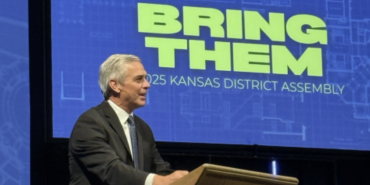Charting a Path Through a Maze of Change

Superimposed over a picture of the Crystal Cathedral in Garden Grove, California, on the cover of the May 23, 2005, issue of Business Week magazine was the headline: "Evangelical America: Big Business. Explosive Politics." The feature article reported on the success of well-known mega churches, including Joel Osteen's Lakewood Church in Houston, Bill Hybel's Willow Creek Church near Chicago, and Rick Warren's Saddleback Church in Southern California.

Osteen was identified as "one of a new generation of evangelical entrepreneurs transforming their branch of Protestantism into one of the fastest-growing and most influential religious groups in America." The article said the "runaway success" of these churches "modeled unabashedly on business" is attributed to their savvy appeal to "a huge potential market—the millions of Americans who have drifted away from mainline Protestant denominations or simply never joined a church in the first place."
The July/August 2005 edition of Outreach magazine included a report on the "Top 100 Largest and Fastest-Growing Churches" in America. Writing for Outreach, researcher John Vaughan, president of Church Growth Today, reported that in 2005, "The first U.S. church passed the 30,000 weekly attendance mark (Lakewood Church, Houston)" and "the number of U.S. mega churches (2,000-plus attendees) passed the 1,000 mark."
Given the visibility and political clout of evangelicals one might assume from these reports that evangelical Christianity—which according to Business Week is "one of the most influential religious groups in America"—is contributing to increased church attendance. Not so.
In the same issue of Outreach, Vaughan wrote: "While U.S. mega churches are growing larger and faster, some researchers believe the American church as a whole is actually in decline. According to 'The American Church Research Project,' statistics for actual counts of people in attendance show that on any given weekend in 2000 only 18.7 percent (52.5 million) of the U.S. population (282 million in 2000) attended a Christian church-down from 20.4 percent in 1990. That figure in 2003 was only 18 percent."
Each year, the U.S. suffers a net loss of 2,400 churches, says the interdenominational group Vision USA. They note that one of the problems is that no churches are being built in many of the subdivisions and commercial areas of high-growth cities. Another problem, says popular religious pollster George Barna in his book Revolution, is a mass exodus of believers from the typical model of a local congregation. He claims these people are "revolutionaries" leaving local churches for what they feel are more dynamic and challenging versions of Christianity. Some may find what they seek in other churches that Barna refers to as "transformational churches."
Many who are leaving congregations still pursue spiritual growth on their own, but are not interested in organized religion.
The U.S. national statistics on church growth, or the lack of church growth, are holding somewhat true in Nazarene churches. In his recent book, New Perspective on Breaking the 200 Barrier, Bill Sullivan cites a study of 4,000 Nazarene congregations in the U.S. from 1993 to 2003. During that time only 14 Nazarene churches increased their attendance from fewer than 150 to more than 350. Drawing from the studies of George Hunter at Asbury Theological Seminary, Sullivan concluded that only about 1 percent of North American churches are growing by the conversion of those who have never received Christ. He says, "With 80 percent of the churches stagnant or declining, the remainder of churches are increasing from biological growth."
Thom Rainer, author of Breakout Churches, describes his search for congregations with long-term pastors that have shown significant growth after a period of decline. Out of 50,000 churches, he found just 13 that met his criteria. He writes, "Of the churches for which we have data, 84 percent are declining or experiencing a growth rate below the population growth rate for their communities. The latter is defined as a plateaued church." Rainer intertwines insights from Good to Great, the best seller on business leadership by Jim Collins, to explain what these 13 congregations did to reverse their decline.
However, writers such as Milfred Minatrea and Reggie McNeal believe that mimicking the business strategies of corporate America won't save the church. In his book, Shaped by God's Heart: The Passion and Practices of Missional Churches, Milfred Minatrea—the director of the Missional Church Center for the Baptist General Convention of Texas—says, "While the U.S. population soars, the percentage of those who hold membership in the Christian church continues to decline. Yet people still seek answers to deep questions of the soul, answers to the 'Why?' of existence." Minatrea says he has seen churches develop a formula for "becoming a new kind of church" by moving from being maintenance-based to mission-oriented.
Reggie McNeal's claims seem to align with Barna's. In his book, The Present Future: Six Tough Questions for the Church, he says, "A growing number of people are leaving the institutional church for a new reason. They are not leaving because they have lost faith. They are leaving the church to preserve their faith."
McNeal, the director of leadership development for the South Carolina Baptist Convention, concluded that the local church as a 'club,' with priority upon membership, money, and attendance needs a 'missional fix.' He suggests local congregations should be evaluated not by size but by effectiveness in transforming their communities. By adopting a business or corporate model, McNeal believes "we have a church in North America that is more secular than the culture." He says, "The problem is that when people come to church expecting to find God, they often encounter a religious club holding a meeting where God is conspicuously absent. It may feel like a self-help seminar or even a political rally."
Without a deep and thorough renewal of mission, McNeal doesn't see much hope for local congregations. He concludes, "I am convinced that most expressions of the institutional church in America will not survive the emerging world." He adds, "If that sounds threatening to you, then you may be more in love with the church than you are with Jesus."
These writers know that increasing numbers of people are not convinced that attending church as we know it is necessary to be a follower of Jesus. The growing number of unchurched people in the U.S. includes more true believers than ever. Sullivan, Hunter, Rainer, Minatrea, McNeal, and many others haven't given up on the church. From extensive life-long experiences with thousands of congregations, they offer hope to those who are willing to step toward reform and renewal by refocusing on the mission of the church. In the words of Robert Quinn, it's either "deep change or slow death" (Quinn, Deep Change).
Let's begin communicating with others in the church to see how we can keep our churches vibrant, alive, and relevant to a community of nonbelievers—And even believers.
Tom Nees served as director of USA/Canada Mission/Evangelism, Church of the Nazarene.
Holiness Today, January/February 2006
Please note: This article was originally published in 2006. All facts, figures, and titles were accurate to the best of our knowledge at that time but may have since changed.




